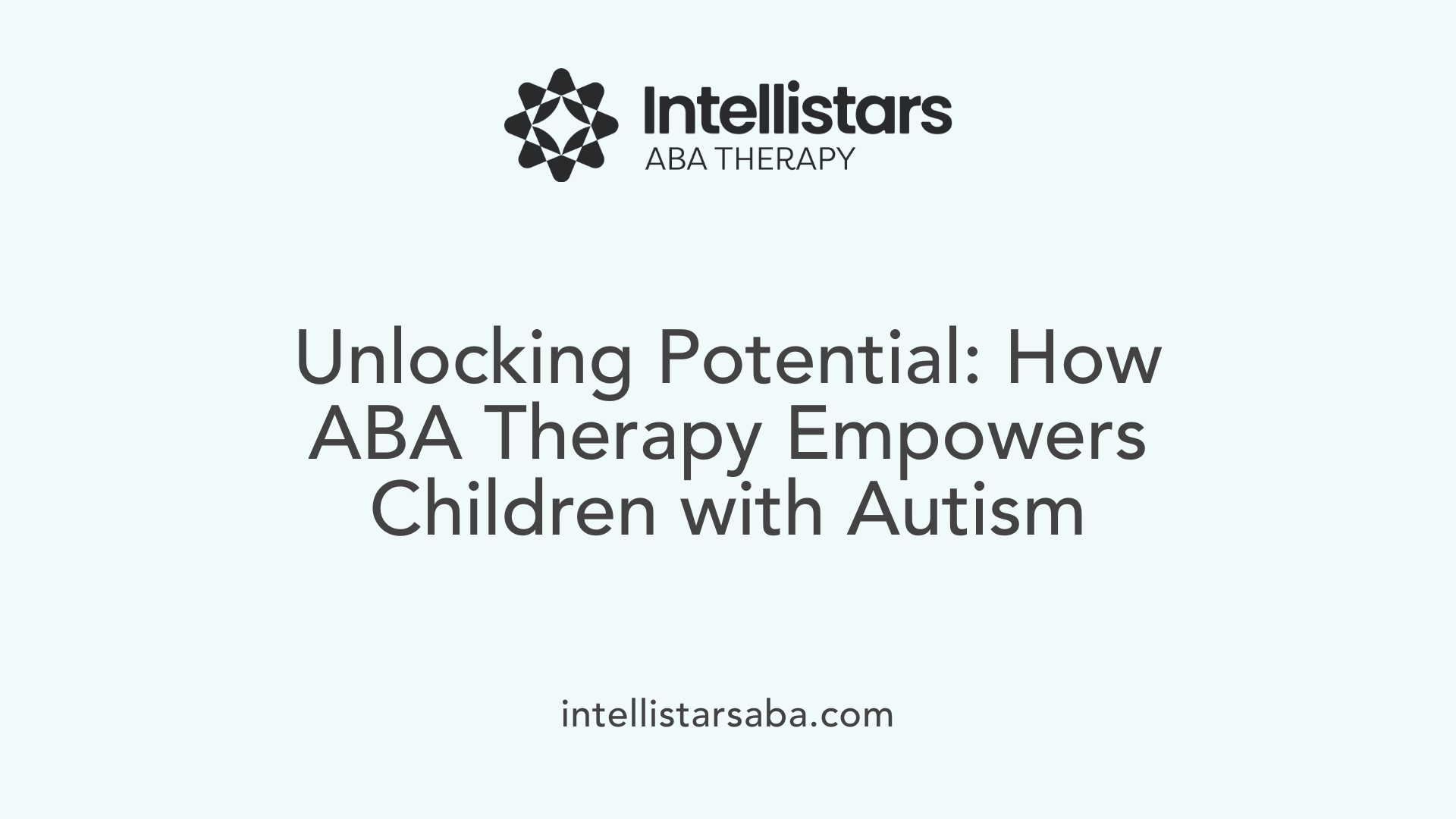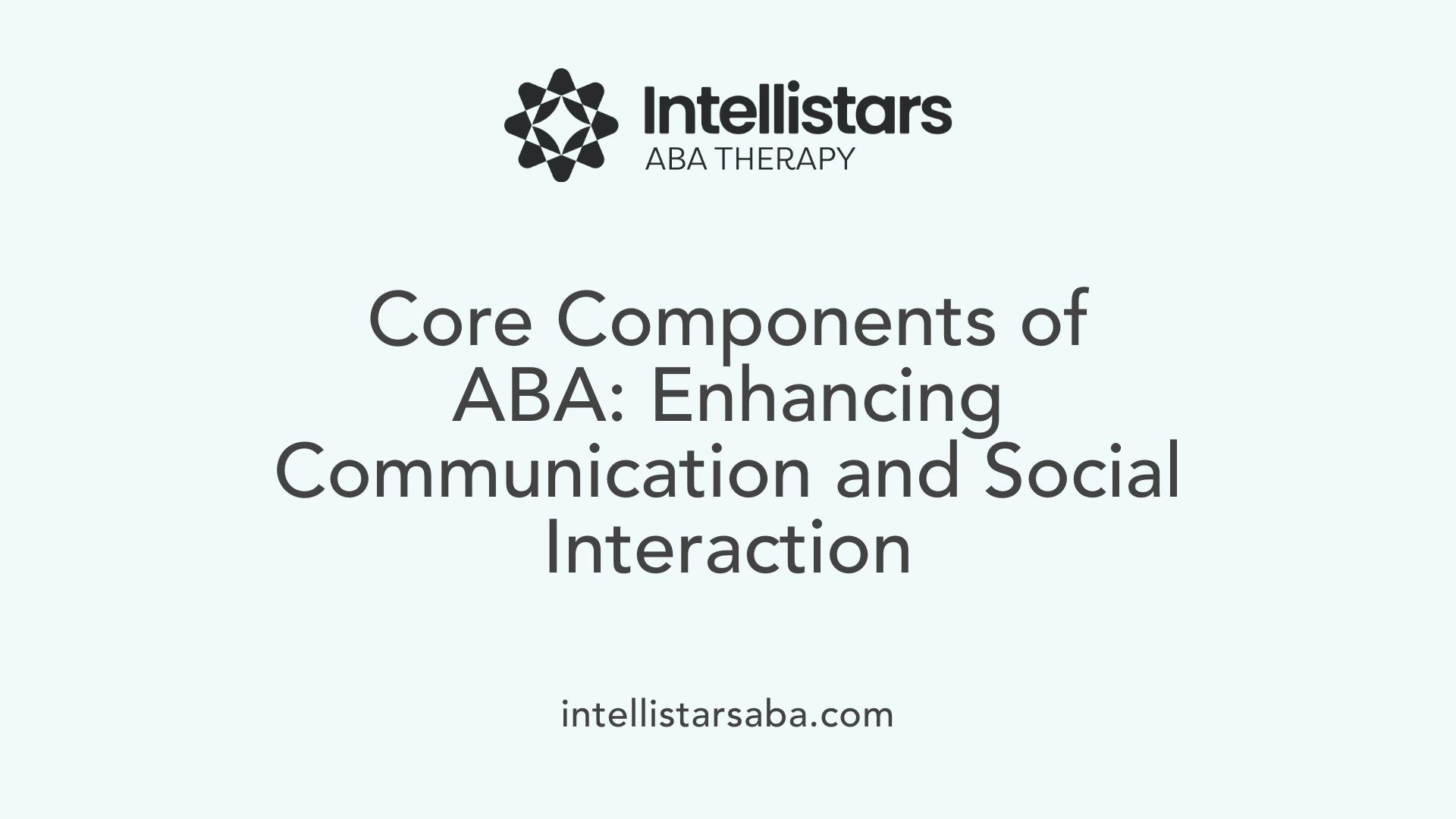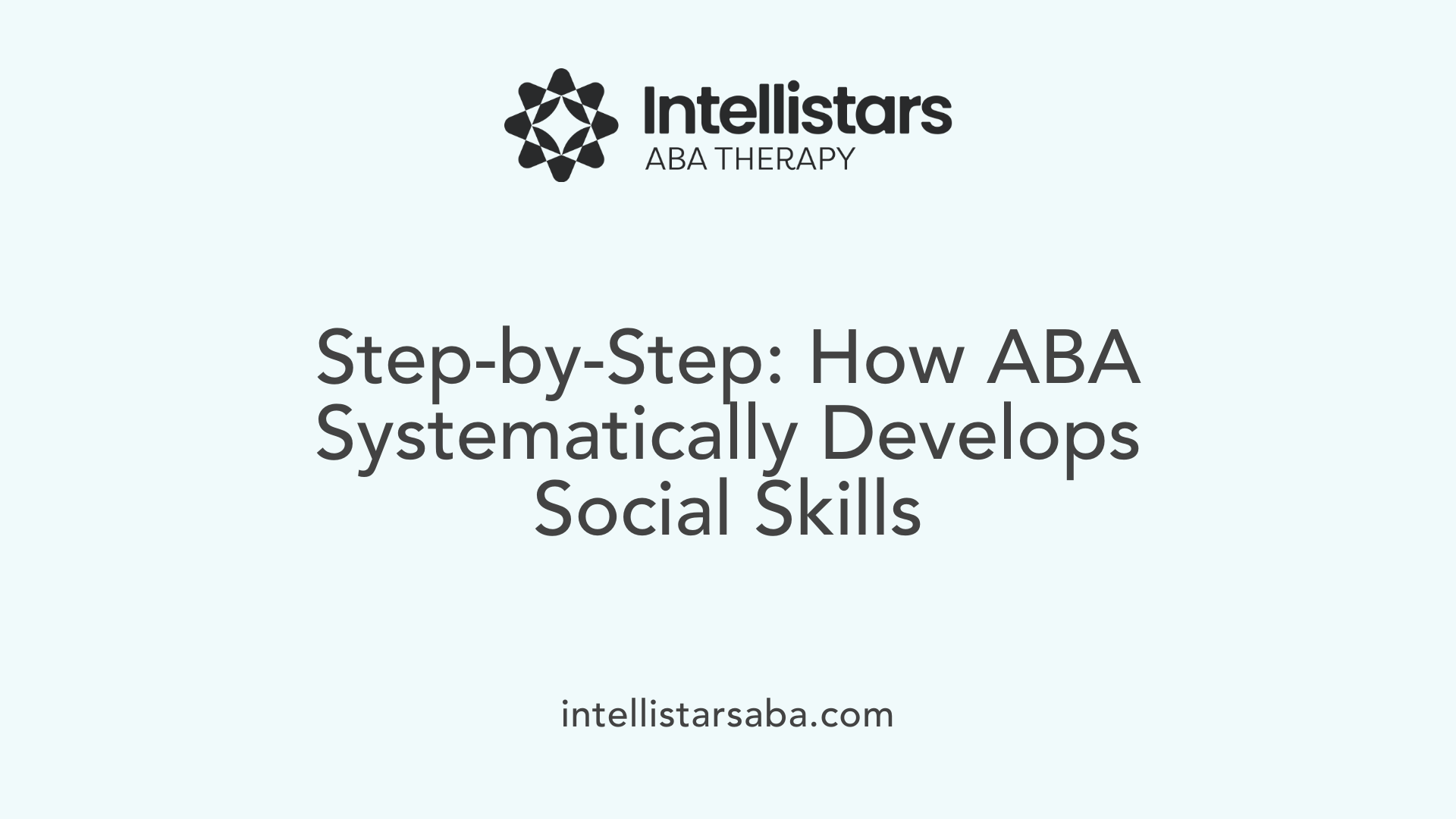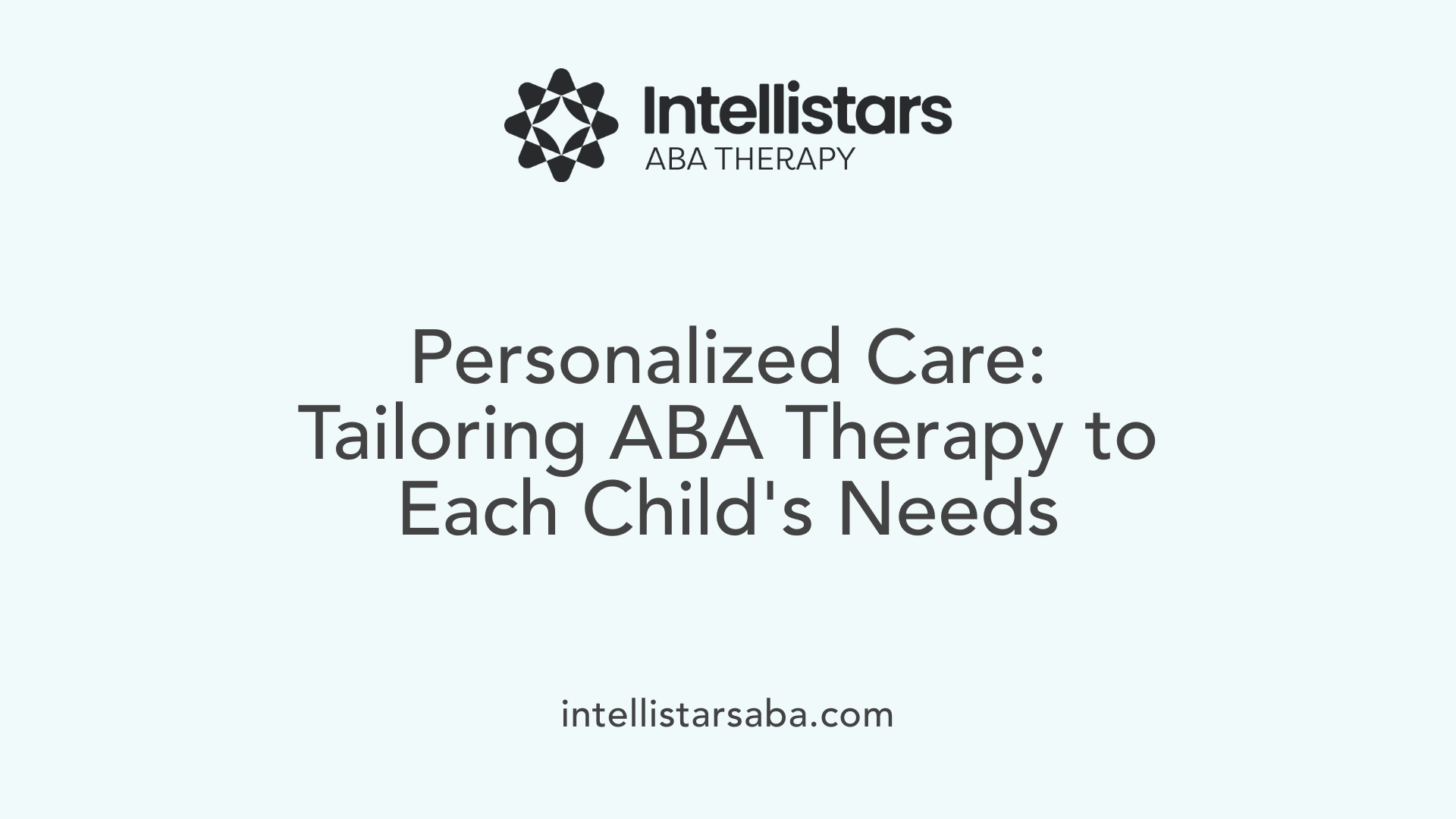Understanding ABA Therapy and Its Focus on Social Communication
Applied Behavior Analysis (ABA) therapy is a cornerstone intervention for children with autism, well-known for its evidence-based, individualized approach to improving essential life skills. Central to its success is social communication training, which helps individuals build meaningful relationships and navigate everyday social environments. This article explores the importance of social communication within ABA therapy, its methodologies, benefits, and how professionals tailor interventions to support each child's unique needs.
What is ABA Therapy and How Does It Support Individuals with Autism?

What is Applied Behavior Analysis (ABA) therapy and how is it used to support individuals with autism?
Applied Behavior Analysis (ABA) therapy is a scientifically supported approach that uses principles of learning and behavior to help children with autism acquire new skills and reduce challenging behaviors. It involves creating structured, individualized programs designed to meet each child's unique needs, mainly focusing on communication, social interaction, academic performance, and daily living skills.
ABA therapy uses positive reinforcement, rewarding desired behaviors to encourage their recurrence. For example, when a child successfully communicates a need, they might receive praise or a preferred item. This method strengthens skills over time by breaking down complex tasks into smaller, manageable steps.
Qualified professionals, such as Board Certified Behavior Analysts (BCBAs), oversee treatment plans, ensuring the therapy is tailored and effective. While many ABA sessions are structured, the approach also embraces naturalistic methods, like incorporating learning into everyday play and routines, which helps children apply skills across different environments.
Parents play a vital role by reinforcing communication and social behaviors at home, using visual aids, modeling, and creating opportunities for interaction. This collaborative effort enhances generalization and long-term success.
Research consistently supports ABA as an effective intervention for autism, highlighting improved communication abilities, reduced problematic behaviors, and better social skills when therapy is started early and delivered consistently.
| Aspect | Description | Impact |
|---|---|---|
| Individualized Plans | Tailored programs targeting communication and behavior goals | Addresses unique strengths and challenges |
| Positive Reinforcement | Rewarding desired behaviors | Encourages skill acquisition and reduces challenging behaviors |
| Qualified Professionals | BCBAs design and supervise treatment | Ensures evidence-based, effective intervention |
| Naturalistic Methods | Incorporates learning in play and daily routines | Promotes skill generalization across settings |
| Parental Involvement | Parents reinforce skills at home | Enhances learning and long-term maintenance |
Overall, ABA therapy provides a comprehensive, flexible framework to support children with autism in developing essential communication and behavioral skills, fostering better social integration and quality of life.
The Goals and Benefits of ABA Therapy for Social Communication Development

What Are the Main Goals and Benefits of ABA Therapy for Individuals With Autism?
ABA therapy is designed to increase helpful behaviors while reducing challenging ones. Its strategies focus on boosting communication and social competence, everyday living skills, and academic achievements.
Increasing Helpful Behaviors and Enhancing Independence
Personalized ABA programs encourage the development of important skills that help children become more independent. By breaking down complex tasks into simpler steps and using reinforcement, ABA fosters language ability and meaningful social interactions.
Reducing Challenging Behaviors
ABA targets behaviors that interfere with learning or social participation. Through systematic teaching and positive reinforcement, these less helpful behaviors decrease, making room for positive communication and social skills to flourish.
Improving Language and Social Skills
ABA therapy supports language development with approaches like Verbal Behavior Therapy and augmentative communication tools for non-verbal children. It teaches social skills such as turn-taking, emotion recognition, and active listening, which are essential for building relationships.
Benefits in Academic and Community Participation
Improved communication and social skills help children succeed academically and engage more fully with peers and community activities. Social skills training often moves from individualized settings to group environments, promoting inclusion and collaboration.
Impact on Quality of Life
By supporting self-regulation, autonomy, and strong social connections, ABA therapy profoundly enhances the overall quality of life for children with autism. These gains empower them to navigate everyday challenges more confidently and enjoy richer social experiences.
Social Communication Training: Core Components in ABA Therapy

What is the Role of Verbal Behavior Therapy (VBT) in ABA?
Verbal Behavior Therapy (VBT) functions as a specialized branch of ABA focused specifically on developing functional communication. It categorizes language into distinct operants such as mands (requests), tacts (labels), echoics (repetitions), intraverbals (conversational responses), and autoclitics (modifiers), allowing therapists to target teaching for each language type systematically.
How is Language Categorized in ABA?
ABA categorizes language operants within VBT to scaffold meaningful client communication. Examples include:
- Mands: Teaching children to make requests that fulfill needs or desires.
- Tacts: Encouraging labeling or commenting about the environment.
- Echoics: Building repetition skills for speech sounds and words.
- Intraverbals: Supporting responsive conversation skills.
- Autoclitics: Refining complex language modifiers.
What Augmentative and Alternative Communication (AAC) Tools Are Used?
For children who are non-verbal or have limited speech, ABA integrates AAC systems such as:
- Picture Exchange Communication System (PECS): Uses pictures to express needs.
- Speech-generating devices: Electrically powered tools that produce spoken words. These aid in advancing communication until speech may develop or as long-term alternatives.
How Are Prompting, Fading, Modeling, Shaping, and Chaining Applied?
ABA employs these techniques to enhance communication skills:
- Prompting: Offering cues to initiate desired responses.
- Fading: Gradually reducing prompts to encourage independence.
- Modeling: Demonstrating desired behaviors or language.
- Shaping: Reinforcing successive steps toward target behaviors.
- Chaining: Breaking down complex actions into manageable sequences.
What Is Natural Environment Teaching (NET)?
NET involves teaching communication skills within authentic, everyday contexts rather than structured settings. This promotes spontaneous use of language and helps children generalize skills across various environments, improving real-world functional communication.
Which Techniques Enhance Functional Communication?
The integration of VBT with prompting, modeling, shaping, chaining, AAC, and NET provides a holistic framework. This encourages children to communicate effectively to meet needs, engage socially, and function independently.
How ABA Therapy Systematically Teaches Social Skills

Breaking down complex social behaviors
ABA therapy approaches social skills by simplifying complex behaviors into smaller, manageable components. This stepwise breakdown allows children with autism to grasp individual elements of social interaction before combining them into fluent, natural exchanges.
Role of shaping, modeling, chaining, reinforcement
Therapists employ techniques such as shaping—rewarding successive approximations of a behavior—and modeling—demonstrating expected social behaviors for imitation. Chaining connects discrete behaviors into sequences, like greeting followed by expressing a feeling. Positive reinforcement encourages repetition of these learned social skills, embedding them into everyday use.
Individualized goal setting
Goals for social skills are tailored to each child's unique strengths and needs. Prior assessments help therapists identify specific skills to target, ensuring that interventions are meaningful and relevant to the child’s daily life and social contexts.
Use of 1:1 settings and social skills groups
Initial teaching often takes place in one-on-one sessions where children can focus without distractions. Once skills are established, group settings provide opportunities to practice with peers, aiding in the generalization of skills across various social environments.
Teaching reciprocal conversations, identifying emotions, nonverbal cues
Key social skills taught include reciprocal conversations—where children learn to take turns speaking—recognition and expression of emotions, and understanding nonverbal communication like facial expressions and body language.
Active listening, turn-taking, boundaries, collaboration, self-advocacy
Additional critical skills encompass active listening, respectful turn-taking during interactions, understanding and respecting personal boundaries, collaborative problem-solving, and self-advocacy to express needs effectively. These skills collectively enhance interpersonal connections and emotional well-being for children with autism.
Tailoring ABA Therapy to Individual Needs

How is ABA therapy typically structured and tailored to meet individual needs?
ABA therapy starts with comprehensive assessments that might include direct observations, caregiver interviews, and standardized tools to pinpoint a child's unique strengths and challenges. These evaluations help behavior analysts gather detailed information about communication skills, social abilities, sensory sensitivities, and behavior patterns.
Based on assessment results, treatment plans are developed with specific, measurable goals designed to be meaningful and motivating. These goals often incorporate a child's personal interests and strengths, making therapy engaging and relevant. For example, if a child shows enthusiasm for art, that interest might be woven into communication or social skills training.
Intervention strategies include evidence-based methods tailored to individual needs, such as positive reinforcement to encourage desired behaviors. Techniques address not only communication and social skills but also any sensory processing concerns that could impact learning and interaction.
Ongoing data collection is a cornerstone of this approach. ABA therapists systematically document progress during sessions, allowing for regular review and timely adjustments to goals or methods as needed. This dynamic process helps maintain effectiveness and responsiveness throughout therapy.
Collaboration with parents and caregivers is vital, as they support generalizing skills across environments like home and community. Therapy plans often involve caregiver training to reinforce learning outside of sessions.
Moreover, culturally sensitive practices ensure ABA therapy respects family values and backgrounds, tailoring communication styles and goals accordingly. This sensitivity enhances engagement and the applicability of learned skills in everyday life.
By combining thorough assessment, personalized goal-setting, continuous monitoring, caregiver partnership, and cultural awareness, ABA therapy delivers individualized support that fosters meaningful progress in children with autism.
The Role of Professionals in Delivering ABA Therapy
Who provides ABA therapy and what qualifications do they typically have?
ABA therapy is delivered by a multidisciplinary team with clearly defined roles and qualifications.
Qualifications of Board Certified Behavior Analysts (BCBAs)
Board Certified Behavior Analysts (BCBAs) lead the ABA therapy process. They hold graduate degrees in behavior analysis or related fields and must pass a rigorous certification exam. BCBAs are responsible for designing individualized treatment plans, overseeing therapy implementation, and ensuring the interventions are evidence-based and effective.
Roles of Registered Behavior Technicians (RBTs) and Behavior Technicians
Registered Behavior Technicians (RBTs) and Behavior Technicians carry out day-to-day therapy sessions. They implement the treatment plans designed by BCBAs, using techniques such as prompting, modeling, and reinforcement. RBTs complete specific training programs, pass competency assessments, and maintain professional eligibility criteria.
Supervision and training requirements
BCaBAs, who have bachelor’s level training, assist BCBAs under supervision. Regular supervision and ongoing professional development are essential for maintaining high-quality services. The BCBA supervises RBTs and Behavior Technicians to ensure they follow protocols and adapt as needed.
Collaboration among therapy teams
ABA therapy often involves collaboration between BCBAs, technicians, educators, speech therapists, and family members. Effective communication within the team supports consistent treatment across settings.
Implementation of treatment plans
The BCBA develops and modifies individualized treatment plans, while RBTs and Behavior Technicians deliver the interventions. This teamwork ensures that behavioral objectives, communication goals, and social skill development are met in a structured, supportive manner.
Evidence Supporting the Effectiveness of ABA Therapy
What evidence supports the effectiveness of ABA therapy in autism treatment?
Numerous clinical studies and meta-analyses have confirmed that Applied Behavior Analysis (ABA) therapy significantly improves communication, social skills, and adaptive functioning in children with autism. Rooted in the science of behavior analysis, ABA uses systematic reinforcement and teaching methods tailored to each child's needs.
Professional organizations, including the American Psychological Association and the US Surgeon General, endorse ABA as one of the most effective evidence-based interventions for autism. Their support underscores ABA's credibility and widespread acceptance in therapeutic communities.
Research highlights that early and intensive ABA intervention yields the greatest benefits. Children receiving therapy during early developmental stages show marked improvements in cognitive abilities, language acquisition, and social engagement. These gains often lead to enhanced independence and better quality of life over time.
The evidence also demonstrates lasting developmental impacts. Communication improvements and reductions in challenging behaviors facilitate deeper social connections and participation in educational settings. ABA's ability to foster these long-term changes is attributed to its use of individualized plans, positive reinforcement, and teaching in naturalistic environments.
In summary, ABA therapy stands on a robust foundation of empirical support, proving its value in developing essential skills and promoting overall well-being for children with autism.
Parental and Caregiver Role in Supporting Social Communication
Creating Communication Opportunities at Home
Parents and caregivers play a vital role in supporting their child's social communication development by creating frequent opportunities to practice skills. Engaging children in daily routines and interactive activities encourages natural exchanges and helps children apply their learning outside therapy sessions.
Using Visual Aids and Joint Attention Strategies
Visual aids such as picture cards or communication boards support understanding and expression. Additionally, practicing joint attention—sharing focus on an object or event—strengthens the foundation for effective communication and social engagement.
Modeling and Positive Reinforcement
Modeling appropriate communication behaviors offers children clear examples to imitate. Reinforcing attempts and successes with positive feedback boosts motivation and helps establish desired communication patterns.
Promoting Generalization of Skills
To ensure skills learned during therapy translate into real-life scenarios, parents should support generalization by encouraging children to use their communication in varied settings and with different people, enhancing adaptability and confidence.
Supporting Emotional Well-Being
Emotional support is essential, as social communication ties closely to emotional health. Parents can foster a nurturing environment that encourages expression, builds self-esteem, and reduces social anxiety, contributing to overall developmental progress.
Integrating Naturalistic and Play-based Methods for Generalization
Why Are Natural Settings Important for Skill Generalization?
Natural settings play a crucial role in helping children with autism apply learned skills beyond structured therapy sessions. When skills are practiced in real-life environments, children are more likely to use them spontaneously and consistently. This natural context supports the transfer of communication and social skills to everyday situations, such as home, school, and community settings.
How Does Spontaneous Social Interaction Enhance Learning?
Spontaneous social interactions encourage children to use their skills in authentic ways. Instead of relying solely on scripted or prompted responses, children engage naturally with peers and adults, reinforcing the relevance and functionality of the behaviors taught. This approach promotes flexibility and creativity in communication and social engagement.
What Are the Benefits of Play-based Learning Within ABA?
Play-based learning integrates fun and meaningful activities into therapy, motivating children to participate and practice skills. Through interactive play, therapists can model communication, turn-taking, and problem-solving skills in an enjoyable context. This method helps children build social connections and facilitates generalization by linking learning to familiar, enjoyable experiences.
How Can Real-life Application of Skills be Fostered?
ABA therapy encourages applying skills across different settings and situations. Therapists and parents create opportunities for children to practice communication and social skills during daily routines, playdates, and community outings. Techniques such as natural environment teaching (NET) and video modeling support children in using skills spontaneously and confidently.
By integrating naturalistic and play-based methods, ABA therapy enhances the likelihood that children with autism will generalize their skills effectively, leading to improved social interactions and a higher quality of life.
Social Communication Training’s Impact on Quality of Life
How Does Social Communication Training Improve Family and Peer Relationships?
Social communication training through ABA therapy enhances interpersonal connections by teaching skills such as reciprocal conversations, active listening, and respecting boundaries. These improvements help children with autism engage more meaningfully with family members and peers, fostering stronger and more positive relationships.
In What Ways Does Social Communication Training Increase Social Inclusion and Community Participation?
By developing functional communication and social skills like turn-taking and interactive play, children become better equipped to participate in group activities and community settings. ABA social skills groups and classes provide opportunities to practice these skills with peers, promoting inclusion and reducing isolation.
How Does Social Communication Training Enhance Academic and Employment Prospects?
Improved communication and social competence contribute to better academic performance by enabling children to follow directions, collaborate with classmates, and engage in classroom discussions. In the long term, these skills support employment readiness by fostering abilities such as teamwork, self-advocacy, and effective workplace communication.
How Does It Boost Self-Esteem and Emotional Well-Being?
ABA therapy’s emphasis on positive reinforcement and achievement of individualized goals promotes a sense of accomplishment. Developing social competence also helps children manage emotions by identifying feelings and engaging appropriately, which contributes to overall emotional well-being and increased self-confidence.
How Does ABA Support Self-Advocacy and Independence?
Through systematic teaching, ABA encourages children to express their needs and preferences clearly, enhancing self-advocacy skills. Combined with communication development and adaptive living skills training, this support fosters greater independence and empowerment in social and daily life contexts.
The Essential Role of Social Communication in ABA Therapy
Social communication training stands at the heart of ABA therapy’s success for individuals with autism. By systematically developing communication and social skills through evidence-based, individualized interventions, ABA empowers children to build meaningful interpersonal connections, participate more fully in their communities, and improve their emotional well-being. Delivered by skilled professionals and supported by families in natural settings, these gains translate into enhanced independence, stronger relationships, and a better quality of life. As the body of evidence continues to confirm the benefits of ABA, the focus on social communication remains imperative for unlocking the potential of each individual on the autism spectrum.
References
- How ABA Therapy Can Improve Communication Skills in ...
- Social Skills through ABA Therapy for Autistic Children
- How ABA Therapy Helps With Social Skills
- Applied Behavior Analysis (ABA)
- Types Of ABA Therapy Jobs And Their Degree Requirements
- Applied Behavior Analysis (ABA)
- Applied Behavior Analysis (ABA)
- The Controversy Around ABA






